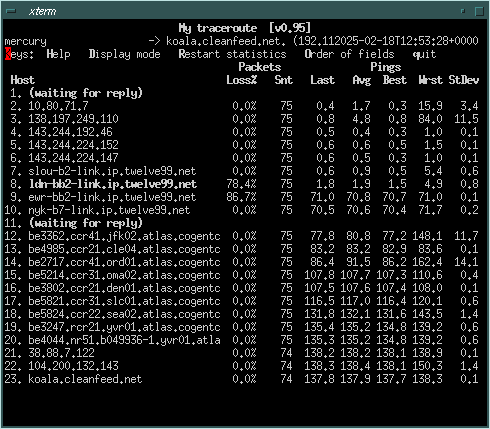You may have heard these words, but what do they mean? They’re relevant to our new receive buffer controls, and for other times you’re streaming sound and picture online. So we present a short technical breakdown, that’s applicable whether you’re working in Cleanfeed or some other system.
Realtime streaming over the Internet doesn’t just require software from people like Cleanfeed, it depends on high performance of a whole chain of individual pieces.
People often view the Internet as a single computer network. Actually, the name comes from “interconnected computer networks”, rather than a single one.
What that means is your audio (or video) packets travel through a set of networks to get from one end of a Cleanfeed connection to the other. Each network is typically run by a different operator or organisation.
Some of these organisations are the internet service providers (ISPs) to homes and businesses that you might have heard of, such as Comcast, Virgin Media or Sohonet. Others are the businesses behind the internet; in a sense these are the “ISPs to the ISPs”, such as Hurricane Electric or GTT.
With tens or even hundreds of thousands of these networks globally, there are at least a handful involved in any Cleanfeed session.
So what happens in cases where one of those intermediate networks is not performing?
The first effect is jitter. Depending on the type of each network and its capacity, individual packets may have to wait behind others. If you drive, imagine the effect when a busy motorway or freeway is reduced from 3 lanes down to two. Jitter describes the difference between the fastest and slowest arrivals at our final destination. Typically we see the jitter at the destination reflect the worst of all the intermediate networks it had to pass through.
The second result is ‘dropped’ (ie. discarded) packets. Contrary to misconceptions, dropped packets on the Internet are not something to be avoided at any cost; they even serve a critical purpose of indicating to the endpoints that congestion is taking place. Problems are exacerbated by poor design and bufferbloat. In these cases, system designers, often under pressure to market their product or service as “0% packet loss”, assumed dropped packets to always be bad and in doing so created a worse trade off for jitter by holding onto the packets and delivering them a long time later.
Cleanfeed handles these effects in several ways. Monitoring for jitter and lost packets allows Cleanfeed to tune for the lowest acceptable latency under the conditions. Because of our use in professional applications, we use different settings than you might find in Zoom, Teams etc.. This, combined with its “clean” unadulterated audio is the default and what makes Cleanfeed unique.
And so now with the addition of the new receive buffer control, you can also push the envelope on more constrained networks when you need it. This further emphasises Cleanfeed as a go-to for radio outside broadcasts.
In one of our customer’s testing with Cleanfeed Cinema, the new controls overcame jitter and packet loss on a 4G mobile to a remote island location, delivering smooth and seamless 2K video streaming with pristine-quality audio!
